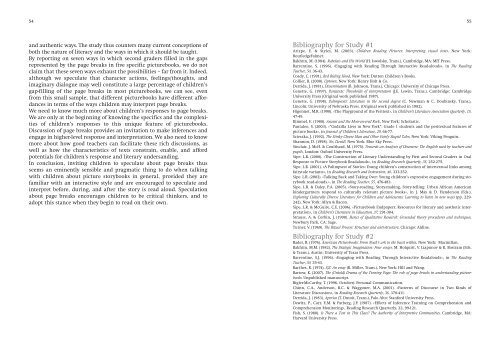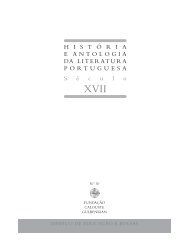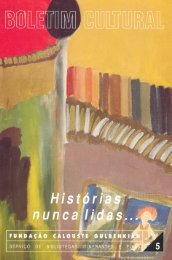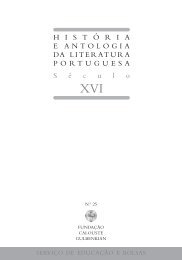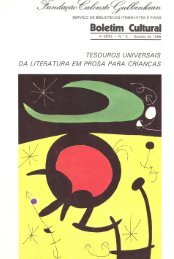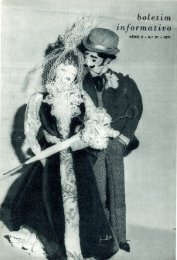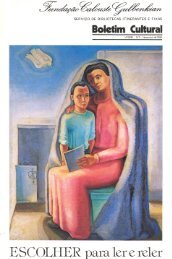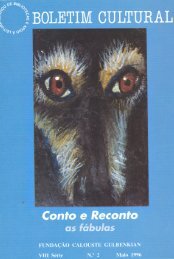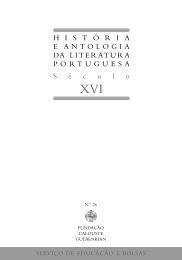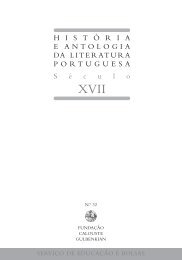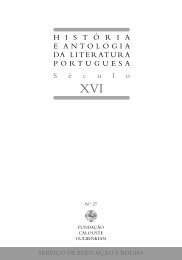Formar Leitores para Ler o Mundo - Leitura Gulbenkian - Fundação ...
Formar Leitores para Ler o Mundo - Leitura Gulbenkian - Fundação ...
Formar Leitores para Ler o Mundo - Leitura Gulbenkian - Fundação ...
Create successful ePaper yourself
Turn your PDF publications into a flip-book with our unique Google optimized e-Paper software.
54<br />
and authentic ways. The study thus counters many current conceptions of<br />
both the nature of literacy and the ways in which it should be taught.<br />
By reporting on seven ways in which second graders filled in the gaps<br />
represented by the page breaks in five specific picturebooks, we do not<br />
claim that these seven ways exhaust the possibilities – far from it. Indeed,<br />
although we speculate that character actions, feelings/thoughts, and<br />
imaginary dialogue may well constitute a large percentage of children’s<br />
gap-filling of the page breaks in most picturebooks, we can see, even<br />
from this small sample, that different picturebooks have different affordances<br />
in terms of the ways children may interpret page breaks.<br />
We need to know much more about children’s responses to page breaks.<br />
We are only at the beginning of knowing the specifics and the complexities<br />
of children’s responses to this unique feature of picturebooks.<br />
Discussion of page breaks provides an invitation to make inferences and<br />
engage in higher-level response and interpretation. We also need to know<br />
more about how good teachers can facilitate these rich discussions, as<br />
well as how the characteristics of texts constrain, enable, and afford<br />
potentials for children’s response and literary undersanding.<br />
In conclusion, inviting children to speculate about page breaks thus<br />
seems an eminently sensible and pragmatic thing to do when talking<br />
with children about picture storybooks in general, provided they are<br />
familiar with an interactive style and are encouraged to speculate and<br />
interpret before, during, and after the story is read aloud. Speculation<br />
about page breaks encourages children to be critical thinkers, and to<br />
adopt this stance when they begin to read on their own.<br />
Bibliography for Study #1<br />
Arizpe, E. & Styles, M. (2003). Children Reading Pictures: Interpreting visual texts, New York:<br />
RoutledgeFalmer.<br />
Bakhtin, M. (1984). Rabelais and His World (H. Iswolsky, Trans.), Cambridge, MA: MIT Press.<br />
Barrentine, S. (1996). «Engaging with Reading Through Interactive Read-alouds», in The Reading<br />
Teacher, 50, 36-43.<br />
Coady, C. (1991). Red Riding Hood, New York: Dutton Children’s Books.<br />
Collier, B. (2000). Uptown, New York: Henry Holt & Co.<br />
Derrida, J. (1981). Dissemination (B. Johnson, Trans.), Chicago: University of Chicago Press.<br />
Genette, G. (1997). Paratexts: Thresholds of interpretation (J.E. Lewin, Trans.), Cambridge: Cambridge<br />
University Press (Original work published 1987).<br />
Genette, G. (1998). Palimpsests: Literature in the second degree (C. Newman & C. Doubinsky, Trans.),<br />
Lincoln: University of Nebraska Press. (Original work published in 1982).<br />
Higonnet, M.R. (1990). «The Playground of the Peritext», in Children’s Literature Association Quarterly, 15,<br />
47-49.<br />
Kimmel, E. (1988). Anansi and the Moss-covered Rock, New York: Scholastic.<br />
Pantaleo, S. (2003). «“Godzilla Lives in New York”: Grade 1 students and the peritextual features of<br />
picture books», in Journal of Children’s Literature, 29, 66-77.<br />
Scieszka, J. (1992). The Stinky Cheese Man and Other Fairly Stupid Tales, New York: Viking Penguin.<br />
Shannon, D. (1998). No, David!, New York: Blue Sky Press.<br />
Sinclair, J. McH. & Coulthard, M. (1975). Towards an Analysis of Discourse: The English used by teachers and<br />
pupils, London: Oxford University Press.<br />
Sipe, L.R. (2000). «The Construction of Literary Understanding by First and Second Graders in Oral<br />
Response to Picture Storybook Readalouds», in Reading Research Quarterly, 35, 252-275.<br />
Sipe, L.R. (2001). «A Palimpsest of Stories: Young children’s construction of intertextual links among<br />
fairytale variants», in Reading Research and Instruction, 40, 333-352.<br />
Sipe. L.R. (2002). «Talking Back and Taking Over: Young children’s expressive engagement during storybook<br />
read-alouds.», in The Reading Teacher, 55, 476-483.<br />
Sipe, L.R. & Daley, P.A. (2005). «Story-reading, Story-making, Story-telling: Urban African American<br />
kindergartners respond to culturally relevant picture books», in J. May & D. Henderson (Eds.),<br />
Exploring Culturally Diverse Literature for Children and Adolescents: Learning to listen in new ways (pp. 229-<br />
242), New York: Allyn & Bacon.<br />
Sipe, L.R. & McGuire, C.E. (2006). «Picturebook Endpapers: Resources for literary and aesthetic interpretation»,<br />
in Children’s Literature in Education, 37, 291-304.<br />
Strauss, A. & Corbin, J. (1990). Basics of Qualitative Research: Grounded theory procedures and techniques,<br />
Newbury Park, CA: Sage.<br />
Turner, V. (1969). The Ritual Process: Structure and anti-structure, Chicago: Aldine.<br />
Bibliography for Study #2<br />
Bader, B. (1976). American Picturebooks: From Noah’s ark to the beast within, New York: Macmillan.<br />
Bakhtin, M.M. (1982). The Dialogic Imagination: Four essays. M. Holquist, V. Liapunov & K. Bostram (Eds.<br />
& Trans.), Austin: University of Texas Press.<br />
Barrentine, S.J. (1996). «Engaging with Reading Through Interactive Readalouds», in The Reading<br />
Teacher, 50, 35-43.<br />
Barthes, R. (1974). S/Z: An essay (R. Miller, Trans.), New York: Hill and Wang.<br />
Bartow, K. (2007). The (Untold) Drama of the Turning Page: The role of page breaks in understanding picturebooks.<br />
Unpublished manuscript.<br />
Bigler-McCarthy, T. (1996, October). Personal Communication.<br />
Chinn, C.A., Anderson, R.C. & Waggoner, M.A. (2001). «Patterns of Discourse in Two Kinds of<br />
Literature Discussion», in Reading Research Quarterly, 36, 378-411.<br />
Derrida, J. (1983). Aporias (T. Dutoit, Trans.), Palo Alto: Stanford University Press.<br />
Dewitz, P., Carr, E.M. & Patberg, J.P. (1987). «Effects of Inference Training on Comprehension and<br />
Comprehension Monitoring», Reading Research Quarterly, 22, 99-121.<br />
Fish, S. (1980). Is There a Text in This Class? The Authority of Interpretive Communities, Cambridge, MA:<br />
Harvard University Press.<br />
55


